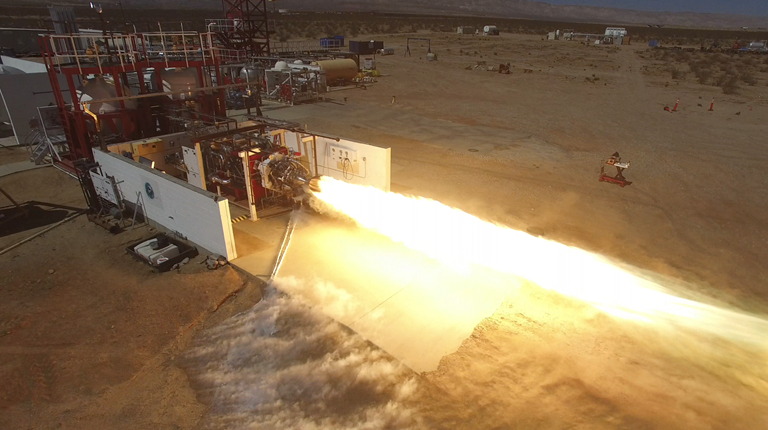Virgin Galactic Claims Progress on LauncherOne Rocket
WASHINGTON — Virgin Galactic announced Sept. 28 that it has made "significant progress" on the engines that it will use on its LauncherOne small satellite launch vehicle, two weeks after the company said it was increasing the vehicle's performance.
In a statement, Virgin Galactic said it had successfully carried out a 20-second test firing of one engine that will be used in the first stage of the air-launched rocket and tested a key component of the vehicle's second stage engine. Those tests took place at the company's test site in Mojave, California.
In a Sept. 25 test, Virgin Galactic fired the NewtonThree engine for approximately 20 seconds on a test stand. The pump-fed engine, which uses liquid oxygen and kerosene propellants, is designed to produce up to 73,500 pounds-force of thrust in LauncherOne's first stage. The test, according to the company, produced "high quality data about the engine during start-up, operation, and safe shutdown." [Virgin Galactic's LauncherOne Rocket in Photos]
The company has also tested the gas generator for the smaller NewtonFour engine that will go on LauncherOne's upper stage. The gas generator, which burns a small amount of propellant to power the engine's pumps, fired for more than six minutes in each of the "full-duration" engine tests.
"There is much work yet to be done, but the NewtonThree and NewtonFour test results are strongly encouraging," George Whitesides, chief executive of Virgin Galactic, said in the statement. "Thanks to our team, our test stands, and our manufacturing facilities, we are making steady progress on all of the key components of LauncherOne."

The engine tests come after Virgin Galactic announced Sept. 14 that it was increasing the payload capability of LauncherOne. When first introduced in 2012, the company said the vehicle could launch payloads of up to 225 kilograms into orbit. With the upgrade, the vehicle will be able to place more than 400 kilograms into a generic low Earth orbit, and 200 kilograms into the sun-synchronous orbit commonly used by remote sensing satellites.
Part of that increased performance comes from the additional thrust that the NewtonThree and NewtonFour engines produce over engines that the company originally developed for LauncherOne, NewtonOne and NewtonTwo, which the company now considers "demonstrator engines." The earlier engines used a simpler pressure-fed design, while the new ones use turbopumps that Virgin Galactic designed in cooperation with Barber Nichols Inc., a company that has built turbopumps for government and commercial customers.
Get the Space.com Newsletter
Breaking space news, the latest updates on rocket launches, skywatching events and more!
LauncherOne will also use a different aircraft as a launch platform. Original plans called for the rocket to be deployed from WhiteKnightTwo, the aircraft Virgin Galactic developed for its SpaceShipTwo suborbital vehicle. Virgin Galactic said Sept. 14 that it is in "the final stages of acquiring a commercial aircraft" that will help enable that increased capacity. The company has not disclosed the specific make of aircraft it plans to use.
This story was provided by SpaceNews, dedicated to covering all aspects of the space industry.
Join our Space Forums to keep talking space on the latest missions, night sky and more! And if you have a news tip, correction or comment, let us know at: community@space.com.

Jeff Foust is a Senior Staff Writer at SpaceNews, a space industry news magazine and website, where he writes about space policy, commercial spaceflight and other aerospace industry topics. Jeff has a Ph.D. in planetary sciences from the Massachusetts Institute of Technology and earned a bachelor's degree in geophysics and planetary science from the California Institute of Technology. You can see Jeff's latest projects by following him on Twitter.

